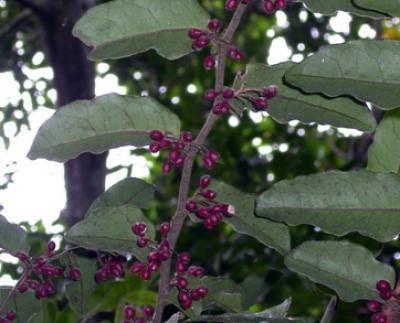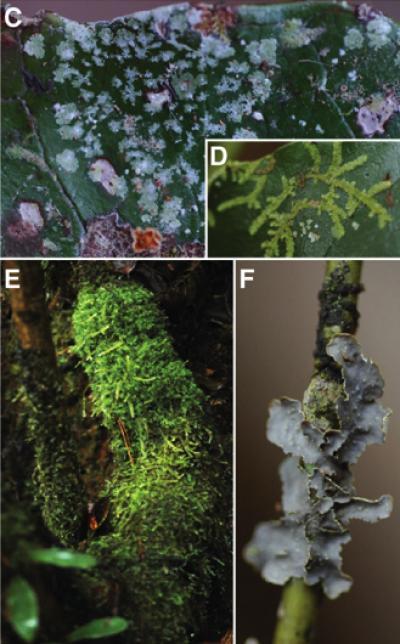Amborella trichopoda, a sprawling shrub that grows on just a single island in the remote South Pacific, is the only plant in its family and genus. It is also one of the oldest flowering plants, having branched off from others about 200 million years ago. Now, researchers from Indiana University, with the U.S. Department of Energy Joint Genome Institute (DOE JGI), Penn State University, and the Institute of Research for Development in New Caledonia, have determined a remarkable expansion of the genome of the plant's critical energy-generating structures. Its mitochondria, the plant's energy-producing organelles, in an epic demonstration of horizontal gene transfer, have acquired six genome equivalents of foreign DNA -- one from a moss, three from green algae and two from other flowering plants. It is the first time that an organelle has captured entire "foreign" genomes, those from other organisms, and the first description of a land plant acquiring genes from green algae.
"It swallowed whole genomes from other plants and algae as well as retained them in remarkably whole forms for eons," said Indiana's Palmer, the senior author of the findings published December 20 in the journal Science. This work reports on the extent of Amborella's genomic gluttony.
The DOE JGI Plant Program focuses on fundamental biology of photosynthesis, the conversion of solar to chemical energy, and the role of terrestrial plants and oceanic phytoplankton in global carbon cycling. Generating models such as the one cited in this published work provides an improved framework for further detailing the origin and mechanisms of mitochondrial fusion and gene transfer across eukaryotes -- plants, fungi, algae. The transfer of genes through wounding, as described in the paper, not only applies to those plants that live in harmony with Amborella but also parasites. By extension, the group of plant parasites that that drain resources from Amborella are representatives of the largest group that sap flowering plants worldwide. Another emphasis of the Plant Program is to understand healthy growth of candidate "biofuel crops" and the threats that plant pests present. The DOE JGI and its collaborators are building a compendium of gene annotation data sets that come to light through its collaborations and are made available through Phytozome and deposited into the DOE's Systems Biology Knowledgebase (KBase).

This is the sprawling shrub native to New Caledonia, Amborella trichopoda, seen here in fruit.
(Photo Credit: Jeffrey D. Palmer)
Sequencing the entire mitochondrial genome, initiated under the DOE JGI's Community Sequencing Program, was an effort that took eight years. To collect samples for study, researchers had to make the long trek to the only place the plant grows: Grande Terre, the main island of New Caledonia, a small nation 750 miles off the eastern coast of Australia.
Researchers' first attempts to sequence this DNA were not as productive as they had hoped. Although they were able to sequence the genes, the techniques they had to use to amplify the DNA didn't allow them to confidently construct a whole genome assembly. It meant going back to the drawing board and producing a second independent draft assembly of the genome, said Palmer. Indiana's Danny Rice, the paper's first author, then combined the two assemblies into a single, complete genome assembly.
"In short, getting a complete assembly of the Amborella mitochondrial genome took years and the effort of several people," said Palmer. "But it was well worth it, because the genome is so utterly unusual, amazing and full of surprises and mechanistic insights." The complete sequence was also necessary to rule out the possibility that any of the foreign DNA was the result of contamination or was integrated in the nucleus rather than the mitochondrion, Palmer said.
The DNA that the Amborella mitochondria absorbed and retained through horizontal gene transfer amounts to at least one million base pairs, with its mitochondrial genome now swollen to an enormous size of 3.9 million base pairs compared with typical plant mitochondrial genomes sizes of around 500,000. Animal mitochondria virtually stopped this process of gene transfer long ago.
The research provides strong evidence for the hypothesis that plant mitochondria can take up new traits by fusing with the mitochondria of other species. In Amborella, the mitochondria have ample opportunities to come into contact with mitochondria of other plants, for example epiphytes, plants that grow on other plants. When injured, Amborella often generates rapid growth at these locations, a virtual petri dish for mitochondria of different species to come into direct contact with each other. This, coupled with a low rate of losing mitochondrial genes over time, has created Amborella's huge mitochondrial DNA glut.
Palmer cited several motivating factors for plumbing the genomic entrails of Amborella's mitochondria. "Although they contain a relatively small number of genes, plant mitochondrial genomes are disproportionately important in terms of basic metabolism. This is because they encode most of the key proteins involved in respiration." He also pointed to defects in plant mitochondrial genes that can cause cytoplasmic male sterility -- when plants fail to produce functional pollen -- a critically important agronomic trait for hybrid seed production. He said that findings from plant mitochondrial genome studies can also be extrapolated to other mitochondrial genomes, to shed light, for instance, on the mechanisms of cellular aging.

Amborella's epiphytes include mosses, liverworts, ferns, and other flowering plants (C to F). Amborella leaves and branches are covered predominantly with lichens ([C] and [F]), leafy liverworts (D), and mosses (E).
(Photo Credit: Jérôme Munzinger)
Source: DOE/Joint Genome Institute